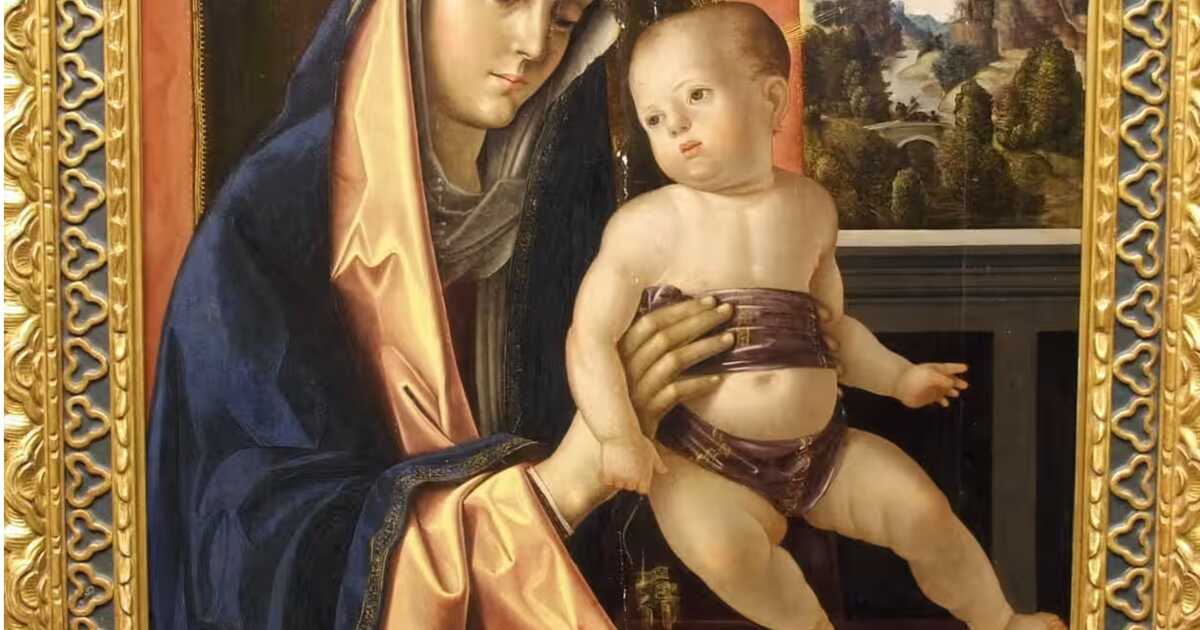Show table of content Hide table of content
In a tale that seems ripped from the pages of a detective novel, a British woman steadfastly refuses to return a stolen Renaissance masterpiece that vanished 52 years ago from an Italian museum. The painting, a Madonna and Child by Antonio Solario, has become one of the most sought-after stolen artworks in the world since its disappearance in 1973.
The mysterious journey of a stolen Italian masterpiece
The story begins in 1973 when Antonio Solario’s Madonna and Child disappeared from the municipal museum of Belluno, Italy, where it had been displayed since 1872. This precious artwork vanished alongside several other paintings in a daring heist that shocked the local art community. While authorities managed to recover some of the stolen pieces shortly after the theft, Solario’s masterpiece seemed to have vanished without a trace.
It wasn’t until decades later that the painting’s whereabouts came to light. The artwork had been purchased in 1973 by Baron de Dozsa as a gift for his wife, Barbara De Dozsa, a British resident of Norfolk county. The couple displayed the Renaissance treasure in their 16th-century residence, East Barsham Manor, apparently unaware of its illicit origins.
News This TikToker buys a used van and realizes it has a hidden surveillance device.
Art theft remains a persistent problem in the global art market, with many stolen pieces disappearing for decades or even permanently. Just as one man spent 12 years searching for a discarded hard drive containing $742 million in Bitcoins, the Italian authorities have been tirelessly hunting for this Madonna and Child for over five decades.
The painting’s reappearance occurred in 2017 when, following her separation from the Baron, Barbara De Dozsa attempted to sell the artwork through a regional auction house. A vigilant individual connected to the Belluno museum recognized the piece and immediately alerted authorities that one of the world’s most wanted artworks had surfaced.
Legal battles and disputed ownership claims
The case stalled significantly during the COVID-19 pandemic, creating further complications in the repatriation process. During this period, British authorities returned the painting to De Dozsa after Italian officials failed to provide adequate documentation proving the artwork’s provenance. This administrative misstep has dramatically complicated recovery efforts.
Barbara De Dozsa now cites the 1980 Limitation Act to justify her refusal to relinquish the masterpiece. This British law stipulates that when someone purchases a stolen item with “no connection to the theft,” they become the legal owner after six years. De Dozsa maintains her late husband acquired the painting in good faith, completely unaware of its stolen status.
The case highlights the complex international nature of art repatriation. Art enthusiasts who visit famous museums like the Louvre rarely consider that some displayed treasures might have controversial ownership histories or that masterpieces like Solario’s continue to be held in private hands against their countries of origin’s wishes.
Adding to the confusion, De Dozsa claims British police provided her with legitimate ownership documents when returning the painting. Law enforcement officials firmly deny this assertion. Christopher Marinello, an attorney specializing in art recovery and founder of Art Recovery International, questions why British police didn’t immediately return the piece to Italy upon confirming its stolen status.
The value dispute behind the refusal
According to Marinello, who coincidentally hails from Belluno himself, Barbara De Dozsa’s motivation appears primarily financial rather than sentimental. Her attempt to sell the artwork in 2017 suggests she doesn’t possess a deep personal attachment to the Renaissance masterpiece.
De Dozsa has cited significant financial burdens associated with the painting, including legal fees exceeding £6,000 plus storage and insurance costs. At one point, she reportedly agreed to return the artwork in exchange for reimbursement of these expenses, only to later withdraw this offer.
News Bat wings after 50? Here’s the most effective exercise, according to a coach.
The financial stakes are considerable. Marinello estimates the Baron likely paid no more than €200 for the painting in 1973, while its current market value ranges between £60,000-£80,000. This substantial appreciation represents a surprising discovery that significantly complicates the restitution process.
Despite De Dozsa’s desire to receive “fair value” for the artwork, Marinello emphasizes the painting’s unsellable status. Italian Carabinieri have registered the piece in their database of stolen artworks, ensuring it would be immediately seized upon entering Italian territory. This registration effectively renders the masterpiece impossible to legally sell on the open market.
International art restitution challenges
This extraordinary case highlights the persistent challenges in international art restitution. Cultural treasures often cross borders through theft, war, or colonial acquisition, creating complex legal scenarios that span multiple jurisdictions and generations.
Marinello views the situation as a demonstration of law enforcement limitations in cross-border art recovery cases. British police classified the matter as civil rather than criminal, significantly reducing their involvement and assistance to Italian authorities seeking the painting’s return.
The Solario case bears similarities to other famous art recovery efforts, such as the hidden treasures of Yosemite National Park that remained concealed for years before proper attribution.
Cultural heritage experts note that stolen artworks often remain in legal limbo for decades. The recent passing of beloved cultural figures reminds us how art connects generations and why nations fight so passionately to recover their stolen cultural patrimony.
As this Renaissance masterpiece remains in British hands despite its documented theft 52 years ago, the case exemplifies the tangled web of international law, national pride, and individual claims that often surround stolen cultural treasures. For now, Solario’s Madonna and Child remains in limbo – found but not recovered, identified but not returned – a priceless cultural treasure caught between two nations and their competing legal systems.


